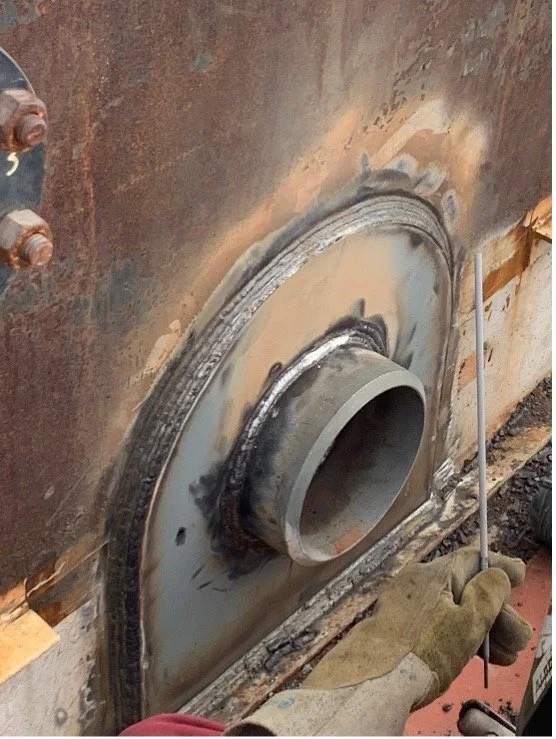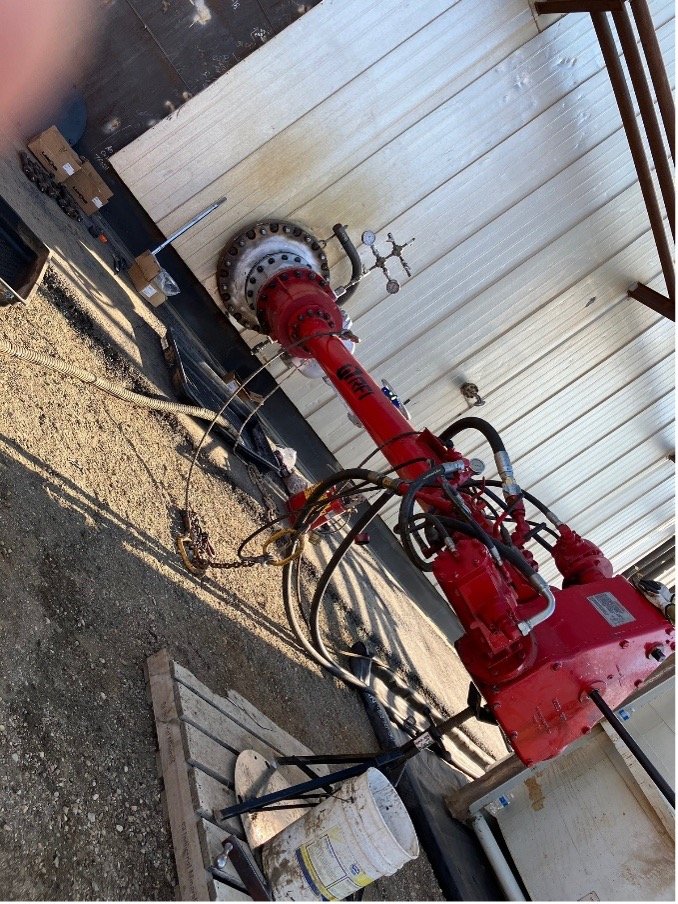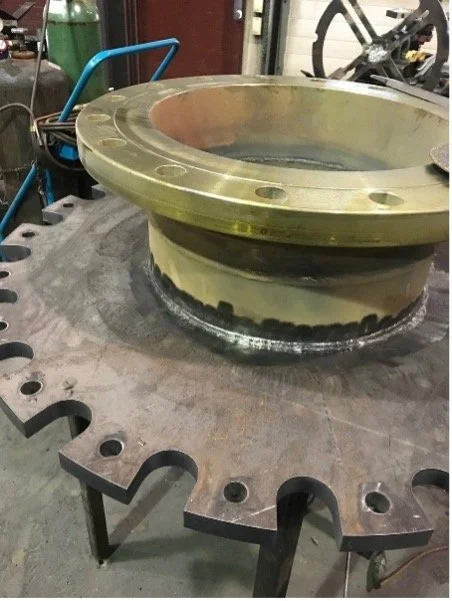
Hot Tap Project Case Study:
In-Servie Installation Of Branch On Tank Manway For Cleaning Cannon Application
PROBLEM
Storage Tanks are known to establish a thick layer of product near the base of the tank due to minimal fluid movement or circulation inside the tank causing the heavier sludge to form at the base of the tank. In addition, many storage tanks have been in operation prior to the design of modern tank cleaning tools, and are not designed with access ports capable of inserting cannons or circulating tools to flush the tank with chemical cleaners.
Per Tank Design Codes, they must be internally inspected on a regular basis (CSA 620 (Canada) – 2 Years/ API 653 – 10 Years). In order for these inspections to be completed on the internal tank wall and tank floor or to complete any repairs, the space must be fully cleaned out and purged to provide a safe atmosphere for working conditions (LEL free if grinding or welding, surface cleaned for MPI Inspections etc.). If sludge and sediment deposit near the base of the tank has blocked drain portsor a large enough drain port does not exist to allow for movement of dense fluid and sediment to exit the tank for further cleaning to be completed, these inspections cannot be completed.
SOLUTION
Red Flame Industries (Taurus Industrial) has designed in-service applications to successfully install a branch and valve to the tank while still containing product and sediment and allow for modern cleaning tools to be utilized and allow for proper drain down.
PERMANENT WELDED APPLICATION
Fig. 1–Nipple With Repad Being Installed
This is done by utilizing an engineered reinforced nozzle with repad and flange, and installed using a specified in-service welding procedure to install a permanent new branch nozzle directly to the tank wall, manway or D-Door for permanent future use.
The tank wall, Manway or D-Door is prepared down to base metal, inspected using Magnetic Particle (MT) and Ultrasonic Thickness (UT) Testing to ensure the material contains no existing defects. If Material Test Records cannot be provided for the specific location on the tank, manway or d-door the locations will be tested using LIBS Analyzers or Spark Test Spectrometry to determining the Carbon Equivalency Value. The location is then tested using an EWI Heat Sink Test to determine the cooling rate is within weld procedure parameters, and amperage checks are completed on the weld machine with a max amperage being set. A weld build up is applied to the parent material of the tank or manway to temper the material and avoid the use of traditional PWHT methods which can create excessive heat inside the tank wall. The weld build up pad (buttering pad) is then inspected again with MT and UT, and the nozzle weld root and fill is completed with a full H4 low hydrogen welding rod to avoid any additional hardness in the weld. The nozzle is then inspected using Ultrasonic shearwave and Magnetic Particle testing and the tempering (buttering) is completed for the repad installation. These welds require a specified delayed cooling period (24-48 Hours) to allow for any hydrogen induced cracking or other defects to occur.
A delayed inspection is completed, and the repad can be installed over the welded nozzle to the buttering pad, again with a full H4 Low Hydrogen Welding rod, and the flange welded to the end of the nozzle. Following MT,UT and X-ray inspection, a full port valve is installed and torqued, and the hot tap machine and cutter can be installed. A pneumatic test is completed on the repad annulus, and a hydro test is completed on the nozzle to tank assembly and hot tap machine for full test of the spool. The hot tap machine is then able to complete a pilot bit cut to center the holesaw and engage the coupon catchers/retainers and finally the coupon itself is cut with a hole saw and retraced back past the valve, and valve closed. The hot tap machine is bled off via drain port to ensure the valve is holding (not passing), and either a blind flange can be installed or the cleaning tool mounted to prepare for circulation of the tank contents.
Fig. 2–Tank Manway Being Drilled via Hot Tap Machine
Temporary Bolted Application
Fig. 3–Adapter Flange Assembly
For applications where the D-Door or Manway is being replaced or welding is not practical, a bolt on manway adaptor flange can be designed and engineered by our team and installed using mechanical hot bolting sequence to seal an adaptor flange directly to the manway or D-door.
The Manway adaptor is engineered and designed to suit the dimensions, material, design conditions/code, and tank product/commodity. The surface of the manway is prepared via sand blasting to bring it to raw material and provide an optimal sealing surface. The adaptor seal/gasket is installed to the back of the adaptor plate, and hot bolting of the existing manway is completed to remove every second stud and nut. The manway adaptor is then installed to the surface of the manway, and hot bolts reinstalled into the flange. The full manway receives a re-torque to the engineered torque spec, and the full port valve is installed to the adaptor flange.
Once the full port valve is installed and torqued, the hot tap machine and cutter can be installed. The whole assembly is supported via pipe stand, rigging or crane depending on location. A hydro test is completed on the full spool to ensure there are no leaks in the adaptor flange connection. This is tested to based on operating pressure compared to full design pressure which is completed on a permanent application. The hot tap machine is then able to complete a pilot bit cut to center the holesaw and engage the coupon catchers/retainers and finally the coupon itself is cut with a hole saw and retraced back past the valve, and valve closed. The hot tap machine is bled off via drain port to ensure the valve is holding (not passing), and either a blind flange can be installed or the cleaning tool mounted to prepare for circulation of the tank contents.
CONCLUSION
Depending on the application, these hot tap nozzles can be installed on quadrants around the tank. Manways are limited to a reducing branch inside the existing bolt zones, however tank walls can be installed as complete new manways or small drain nozzles for any application.
TANK CLEANING & DRAINING APPLICATION
Once branch nozzles are installed, an insertable cleaning cannon can be mounted to the full port valve, equalized and entered through the nozzle to direct chemical or water circulation. This can be completed and left to soak or utilizing a drain vacuum system to assist in removal of the tank contents for disposal.



